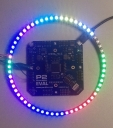WS2812 smartpin driver
 ozpropdev
Posts: 2,793
ozpropdev
Posts: 2,793
in Propeller 2
Hi All
Here's a demo of a WS2812 driver using smartpins.
A table is generated in LUT of 24 bit patterns representing color byte waveforms.
A smartpin is configured in sync tx mode and fed with the LUT patterns.
The same sync tx smartpin gets its clock source from a neighbour smartpin configured in transition mode.
More "lanes" can easily be added(5 more of the same clock) by adding more sync tx smartpins.
Here's a demo of a WS2812 driver using smartpins.
A table is generated in LUT of 24 bit patterns representing color byte waveforms.
A smartpin is configured in sync tx mode and fed with the LUT patterns.
The same sync tx smartpin gets its clock source from a neighbour smartpin configured in transition mode.
More "lanes" can easily be added(5 more of the same clock) by adding more sync tx smartpins.
{
Prop2 WS2812 demo using smartpins
Version 0.2
ozpropdev Feb 15th 2019
}
sys_clk = 25_000_000
us = sys_clk / 1_000_000
ws2812_load = 51 * us
_200ns = us * 200 / 1000
num_leds = 64
clk = 14
ws2812 = 15
dat org
hubset #0
wrpin #%1_00101_0,#clk 'transition mode
wxpin ##_200ns,#clk
dirh #clk
wrpin ##%1111 << 24 | %1_11100_0,#ws2812 'sync tx mode
wxpin #%1_00000 | 23,#ws2812
dirh #ws2812
'build ws812 waveform data into lut for each byte
'e.g. byte $8c becomes %001_001_011_011_001_001_001_011
mov index,#0
build mov count,#8 'number of bits
mov pa,index
mov pb,#0
.loop testb pa,#7 wc
shl pb,#3
or pb,#1 '0 = %100 (1/3 t)
if_c or pb,#%10 '1 = %110 (2/3 t)
shl pa,#1
djnz count,#.loop
shl pb,#32-24
rev pb 'prepare for msb shifted first
wrlut pb,index
incmod index,#255 wz
if_nz jmp #build
getct time
addct1 time,delay
'Main loop
'send data to ws2812 devices
update_ws2812 loc ptra,#@led_buffer 'iitialize pointer
mov leds,#num_leds
next_led rdlong rgb,ptra++ 'get grb data
mov count,#3 '3 * 8 bits
next_color getbyte pb,rgb,#2 'get color byte
shl rgb,#8
rdlut pa,pb 'convert to waveform
wypin pa,#ws2812 'load sync tx with 24 bit waveform
wypin #48,#clk 'start 48 clock transitions
busy testp #clk wc 'wait for smartpin completion
if_nc jmp #busy
rdpin 0,#clk 'clear smartpin
djnz count,#next_color
djnz leds,#next_led
waitx ##ws2812_load 'data low for >50Us
'shift led pattern in led buffer
pollct1 wc
if_nc jmp #update_ws2812
addct1 time,delay
loc ptra,#@led_buffer
loc ptrb,#@led_buffer+4
rdlong pb,ptra
rep #2,#63
rdlong pa,ptrb++
wrlong pa,ptra++
wrlong pb,ptra
jmp #update_ws2812
time long 0
delay long sys_clk / 20
count long 0
index long 0
rgb long 0
leds long 0
lut long 0
orgh $400
led_buffer
long $00_1f_00_00[4] 'green
long $00_00_1f_00[4] 'red
long $00_00_00_1f[4] 'blue
long $00_00_1f_1f[4] 'magenta
long $00_1f_00_1f[4] 'cyan
long $00_1f_1f_00[4] 'yellow
long $00_1f_1f_1f[4] 'yehite
long 0[4]
long $00_1f_00_00[8] 'green
long $00_00_1f_00[8] 'red
long $00_00_00_1f[8] 'blue
long $00_00_1f_1f[8] 'magenta



Comments
Enjoy!
Mike
Smartpins make this so easy. A single cog can control a huge amount of leds.
BTW this is running in RCFAST mode with no problems.
Included is a Spin2 demo driving 51 strips of 60 leds at 32MHz.
Tested on a Eval board wuth PNut_v34o.
Or, just use the streamer for data directly. It doesn't use any external clock source anyway. Would have to format the multi-pin interleaved data pattern into hubram though.
A Spin2 example is here: forums.parallax.com/discussion/comment/1492328/#Comment_1492328
Andy
And it kind of obeys another behaviour of async serial too - A required gap for identifying the frame start. UARTs can't detect the start bit in a gapless stream.
Why do you think so? Here is a drawing that shows how the bits are encoded:
EDIT: BTW: Your diagram is so much easier to read than the datasheet I've downloaded.